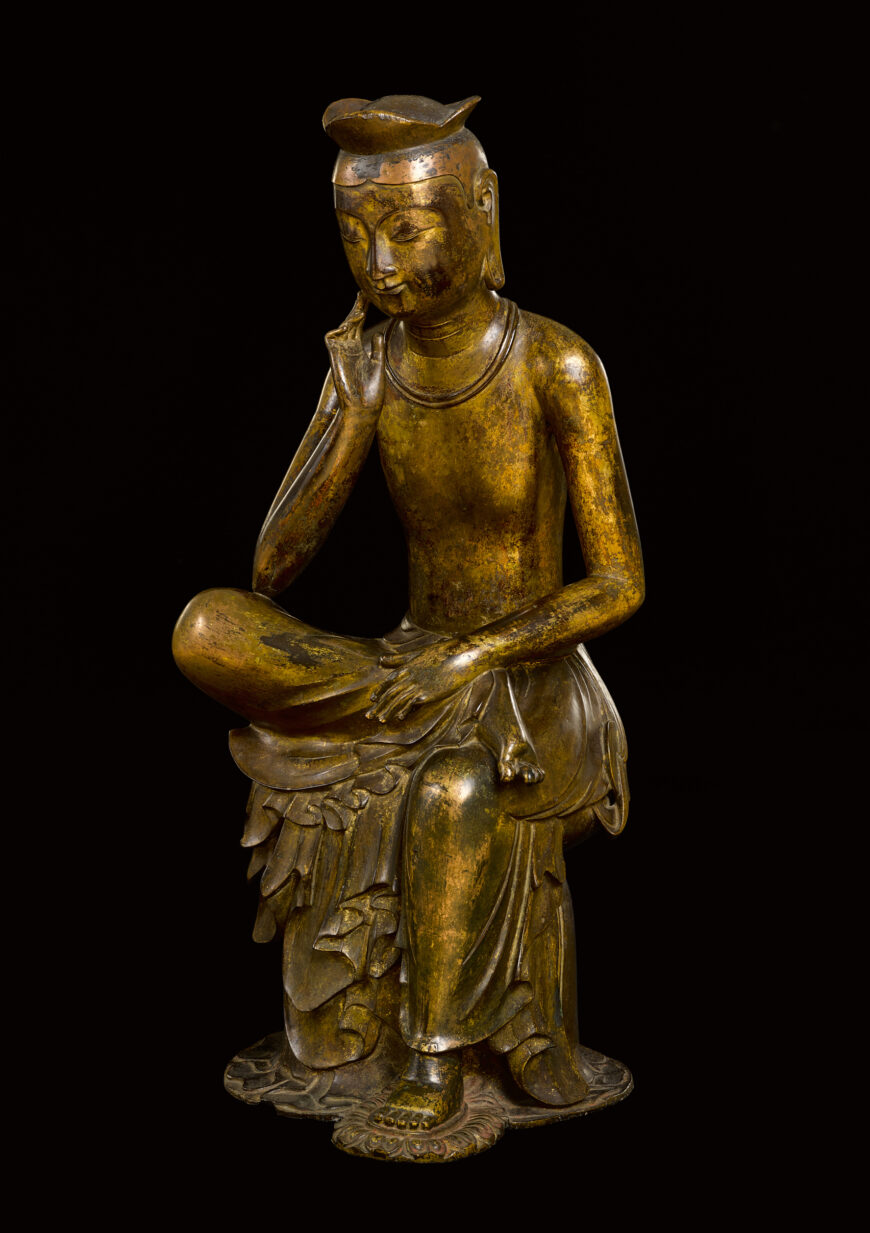
Pensive Bodhisattva (National Treasure #83), early 7th century (Three Kingdoms Period), gilt-bronze, 93.5 cm high (National Museum of Korea, Seoul)
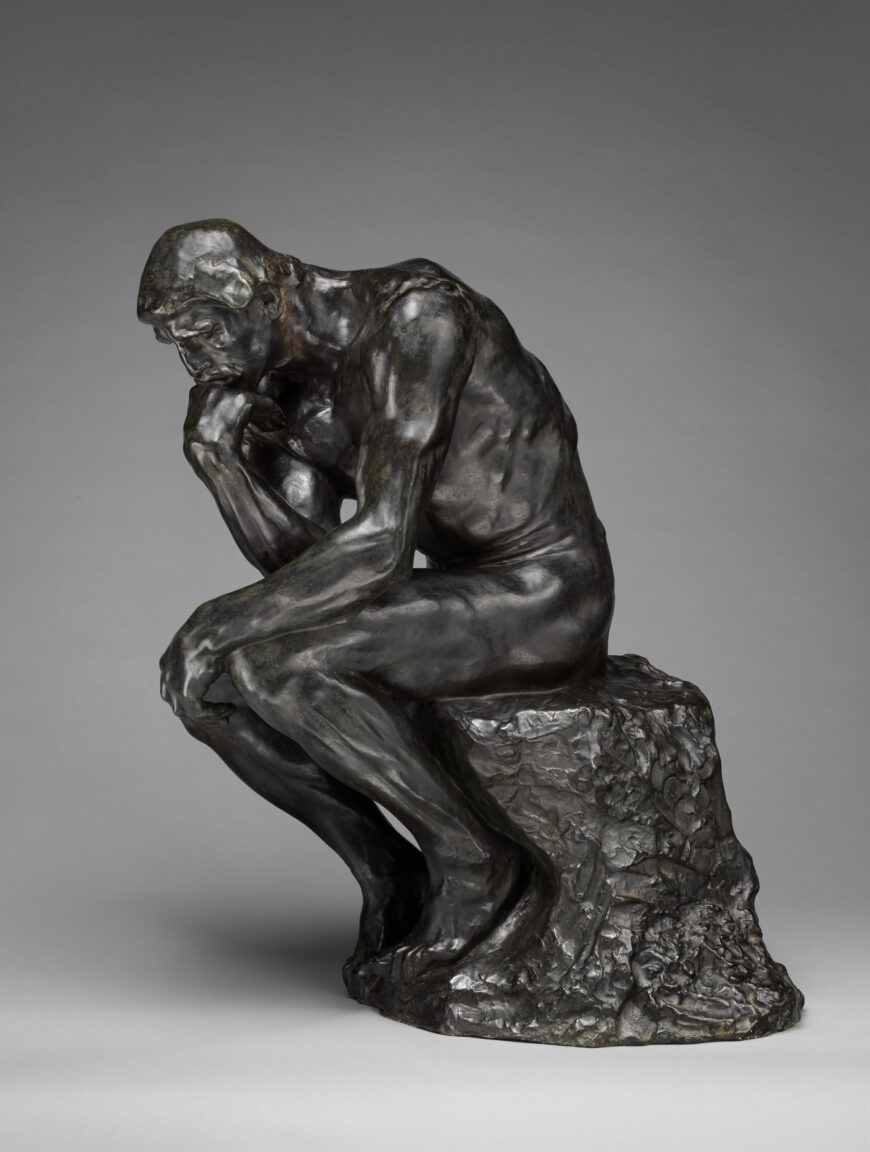
Auguste Rodin, The Thinker, cast c. 1910, bronze, 70.2 cm high (The Metropolitan Museum of Art, New York)
One of the most famous and beloved Buddhist statues in Korea is the Pensive bodhisattva designated as National Treasure #83. In Korean, sculptures of this type are called “banga sayu sang,” with “banga” referring to the distinctive positioning of the figure’s legs (with one leg raised to rest horizontally across the other vertical leg), “sayu” indicating contemplation or pensiveness, and “sang” meaning a statue or image.
Like many sculptures on the theme of thinking or contemplation, this work calls to mind another well-known sculpture that emerged from a completely different context: Auguste Rodin’s The Thinker. Looking at the figures in these two works of art, it is probably easier for us to relate to the man in The Thinker, who shows the gravity and anguish that we tend to associate with deep thought, with a furrowed brow, tightly sealed lips, and chin pressing down upon the back of his hand. The Pensive Bodhisattva also seems to be absorbed in thought, with his eyes half-closed, his head tilted slightly forward, and his fingers placed gently on his cheek. But unlike the man in The Thinker, the divine bodhisattva shows an expression of pure serenity, with his lips curling slightly upward in a near smile. We cannot help but wonder, what is he thinking? And why is he smiling?
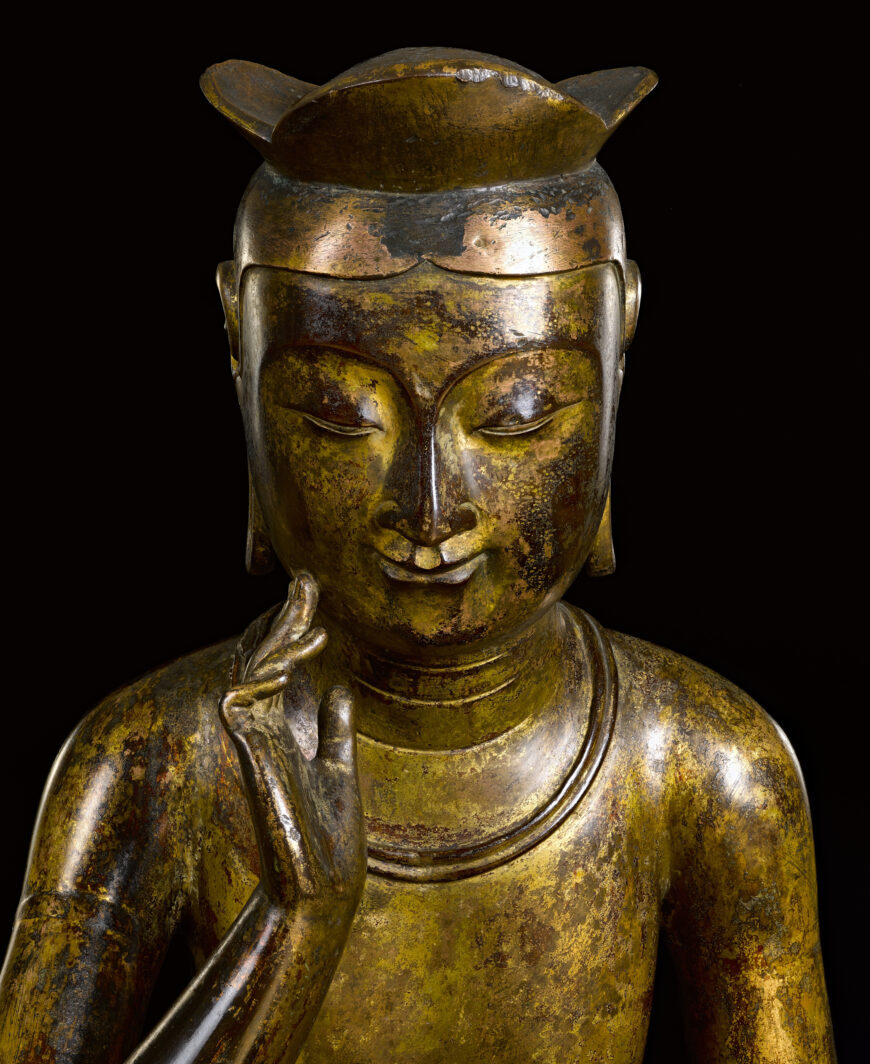
Face (detail), Pensive Bodhisattva, early 7th century (Three Kingdoms Period), gilt-bronze, 93.5 cm high, National Treasure 83 (National Museum of Korea, Seoul)
Iconography of the pensive bodhisattva
The theme of a bodhisattva in this pensive pose can be traced back to 2nd- and 3rd-century images from Gandhara and Mathura in what is now India, Pakistan, and Afghanistan, major centers of early Buddhist art. In particular, East Asian images of the pensive bodhisattva are often said to have originated from Gandharan reliefs of Gautama Siddhartha (who attained enlightenment and became Shakyamuni Buddha) engaged in his first meditation. According to Buddhist scripture, the young Prince Siddhartha once came across a farmer and his bull plowing a field. As he watched their strenuous efforts, while also noticing insects being eaten by birds, the prince became filled with pity for all living creatures. He then began to meditate under a jambu tree, where he eventually realized the transient nature of life and the world. Over time, this episode and related images of Prince Siddhartha in meditation were transmitted to East Asia, inspiring similar Chinese works called “taizi siwei xiang,” or “pensive image of the crown prince.”
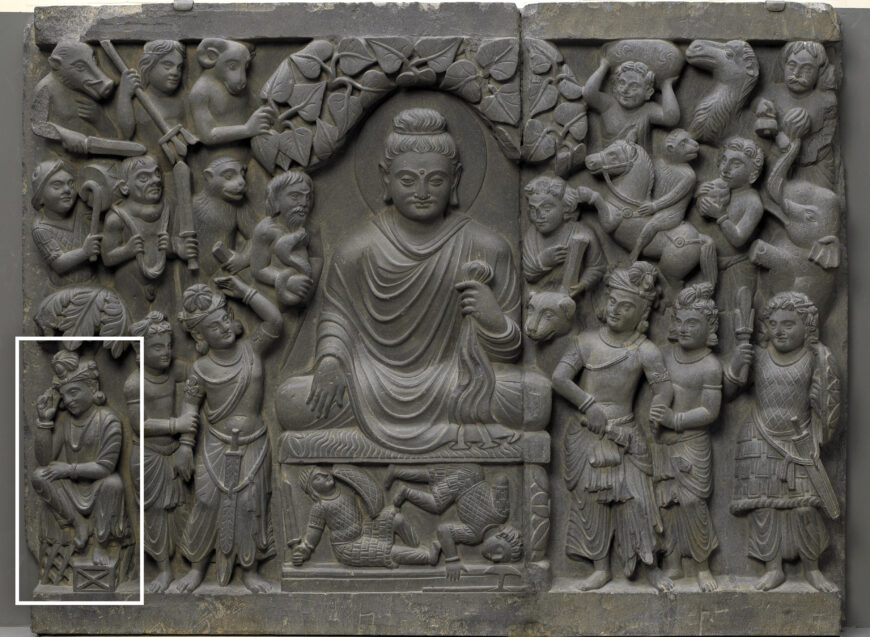
Demon Mara in pensive pose in “Mara’s Attack,” Scenes from the Life of the Buddha, 2nd or 3rd century (Gandhara), grey schist, 67 cm high (National Museum of Asian Art, Washington, D.C.)
In Gandharan and Mathuran art, the signature seated pose of the pensive bodhisattva was not exclusively associated with scenes of Siddhartha in meditation. Other figures who were sometimes depicted with this pose include Demon Mara and Seer Ashita in narrative scenes, anonymous attendants in scenes of the Buddha preaching, and Avalokiteshvara Bodhisattva, in both independent and flanking images. After this motif was transmitted to China, it seems to have developed to encompass new ideas and conceptions. For example, in addition to the aforementioned “pensive image of the crown prince,” other Chinese images of figures in this pose were inscribed simply as “siwei xiang,” or “pensive image.” While some regard this phrase as a mere abbreviation of “taizi siwei xiang” (“pensive image of the crown prince”), others feel that it demonstrates an increasing interest in the theme of contemplation or pensiveness itself. Another key term found in related inscriptions is “longshu siwei xiang,” or “pensive image under a dragon tree.” This phrase seems to be related to Maitreya, the Future Buddha who Buddhists believe will descend to this world from Tushita Heaven 5,670,000,000 years after the nirvana of Shakyamuni, the Buddha of the present world. The “dragon tree” is thought to correspond to the “dragon-flower tree” (longhua shu) under which Maitreya will reputedly give three sermons.

Left: Pensive Bodhisattva, 6th century (probably from Hebei, China), marble, 44 cm high (National Museum of Korea, Seoul); right: Pensive Bodhisattva, c. 575 (probably from Hebei, China), marble, 33 cm high (National Museum of Asian Art, Washington, D.C.)
In China, pensive bodhisattva images first appeared in the 5th and 6th centuries. Initially, the pensive pose was primarily limited to narrative scenes or secondary figures, but by the mid- to late 6th century, independent images of figures in this pose were increasingly produced, mostly in the Hebei and Shandong regions of China. In Korea, pensive bodhisattva images were popularly produced in the 6th and 7th centuries, many of which were intended as the main icons for worship. In China, most independent pensive bodhisattva images were made from stone, while gilt-bronze or bronze was favored in Korea.
Unfortunately, no relevant inscriptions of Korean pensive bodhisattva images have survived, making it almost impossible to trace their iconography. However, these images are widely believed to be associated with the worship of Maitreya, which also gained popularity in the 6th and 7th centuries. Supporting this premise, some later texts describe the importance of Maitreya worship among the Hwarang (“flower boys”), an organization of young aristocratic warriors of the Silla Kingdom which rose to prominence in the mid-6th century. Records also indicate that followers of the famous Silla general Kim Yusin were known as “Yonghwa Hyangdo” (“Dragon Flower Aspirants”), alluding to the dragon-flower tree under which Maitreya will preach. However, it is impossible to know whether all pensive bodhisattvas of this era were associated with Maitreya, or whether any of them were meant to depict the general theme of pensiveness.
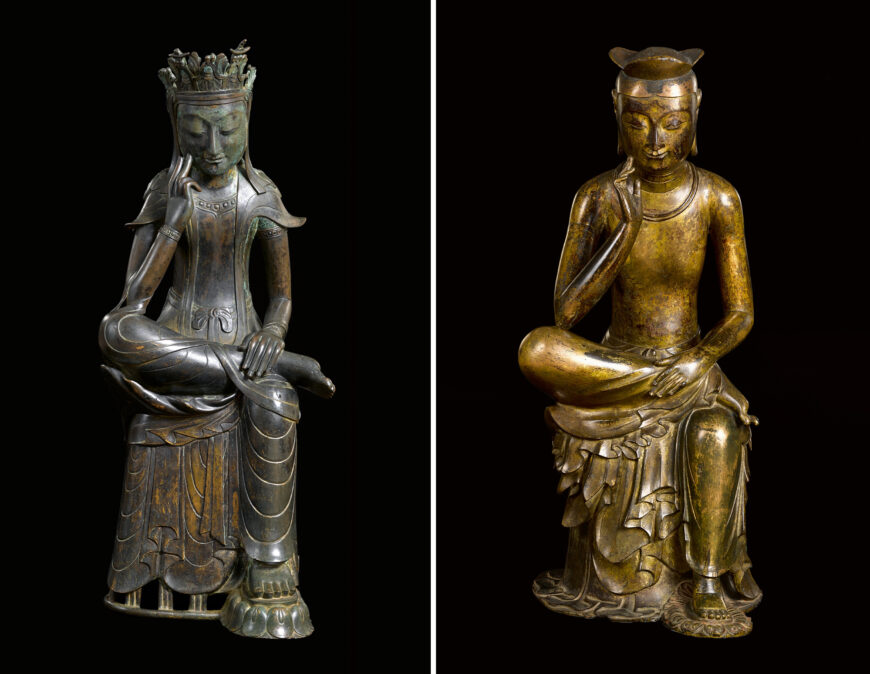
Left: Pensive Bodhisattva (National Treasure #78), late 6th century (Three Kingdoms period), gilt-bronze, 83.2 cm high (National Museum of Korea, Seoul); right: Pensive Bodhisattva (National Treasure #83), early 7th century (Three Kingdoms Period), gilt-bronze, 93.5 cm high (National Museum of Korea, Seoul)
The most famous pensive bodhisattvas
Today, approximately 40 pre-modern Korean pensive bodhisattva images are extant. Among them, the two most famous examples are National Treasure #78 and National Treasure #83.
Although both images were originally created as objects of religious worship, they are now also recognized as masterful works of art. The positions of the arms and legs were meticulously calculated to attain the most graceful depiction of their complex pose. The bodies are well proportioned and elegantly adorned with various intricate details for added balance and splendor. Comparing the two, National Treasure #78 features more decorative details, such as the crown, necklace, and sashes across the shoulders, while #83 shows a more three-dimensional and realistic rendering of the body, accentuated by irregularly cascading folds beneath the legs. While #83 also wears a crown and necklace, the surface of the body is completely undecorated, emphasizing the natural form.
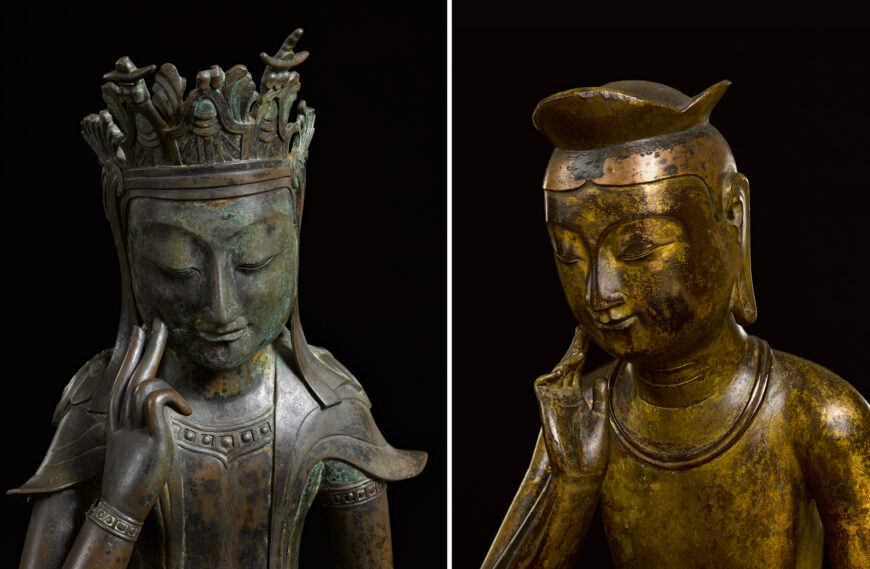
Left: face (detail), Pensive Bodhisattva (National Treasure #78), late 6th century (Three Kingdoms period), gilt-bronze, 83.2 cm high (National Museum of Korea, Seoul); right: face (detail), Pensive Bodhisattva (National Treasure #83), early 7th century (Three Kingdoms Period), gilt-bronze, 93.5 cm high (National Museum of Korea, Seoul)
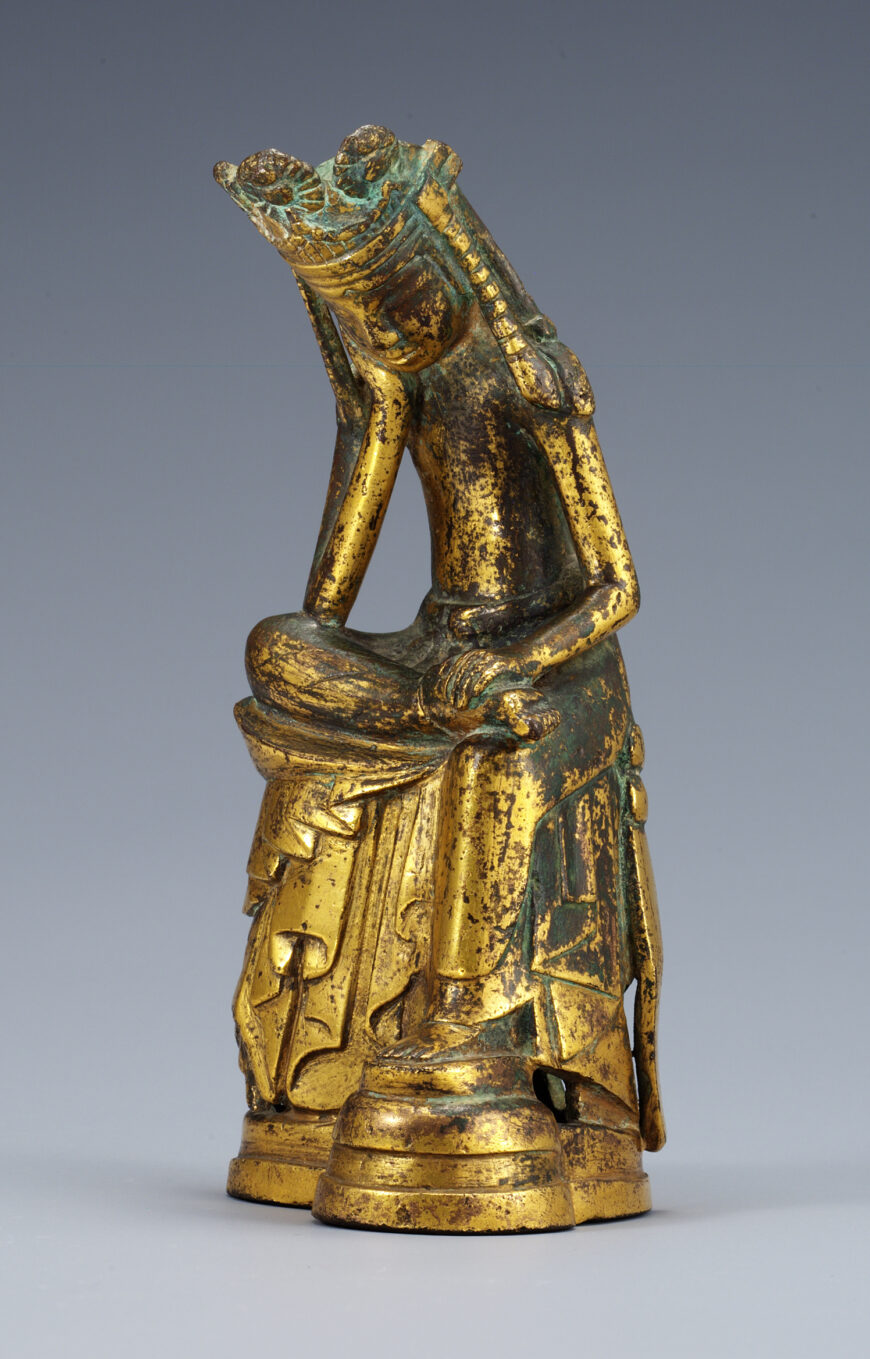
Pensive Bodhisattva, Three Kingdoms period gilt-bronze, 17.1 cm high (National Museum of Korea, Seoul)
Among all the marvelous details on these two sculptures, viewers are most often amazed by their facial expressions. Both bodhisattvas are obviously immersed in thought, yet they each have a subtle smile on their face. A clue to understanding this smile can be found in the scriptures that relate the story of Siddhartha’s first meditation. It is written that, when the prince realized the transient nature of the universe, his mind became utterly composed and his worldly desires disappeared. Hence, one might speculate that the producers of pensive bodhisattva images were likely trying to capture the precise moment of realization. However, not all Korean pensive bodhisattvas wear a smile on their face; some have a more serious or a blank expression, with their upper body leaning dramatically forward. Thus, it would seem that those who produced the two National Treasure Pensive Bodhisattvas wished to combine both the idea of meditation and the realization of the truth, an objective that they brilliantly achieved.
The two images, both of which are hollow, are also notable in terms of their casting technique. They are the largest pensive bodhisattva images made from bronze, but their layers of bronze are remarkably thin and even. The bronze layer of National Treasure #78 is between 2 and 5 mm, while that of National Treasure #83 is around 10 mm.
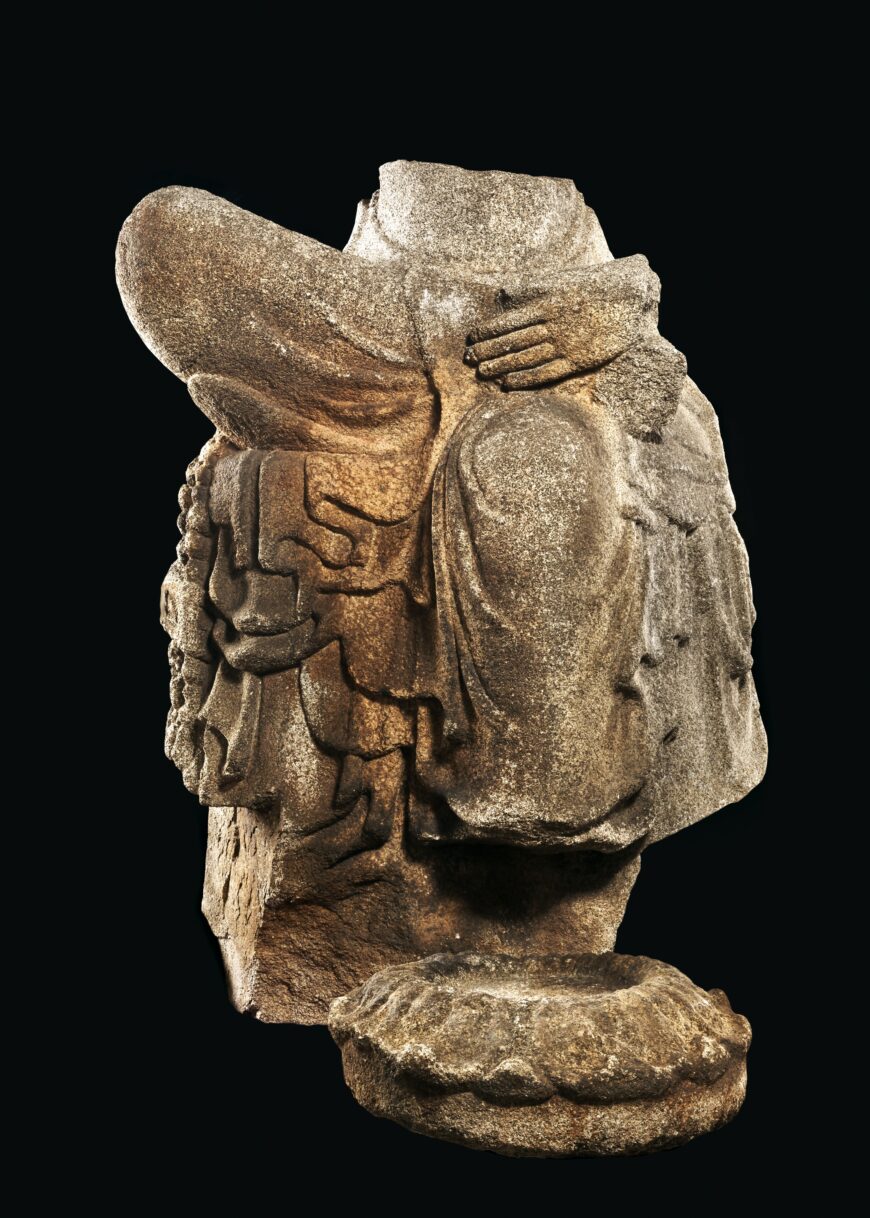
Pensive Bodhisattva, Bukjiri in South Gyeongnam-do Province, late 7th century, 170 cm high (Kyungpook National University Museum, Daegu)
The largest pensive bodhisattva
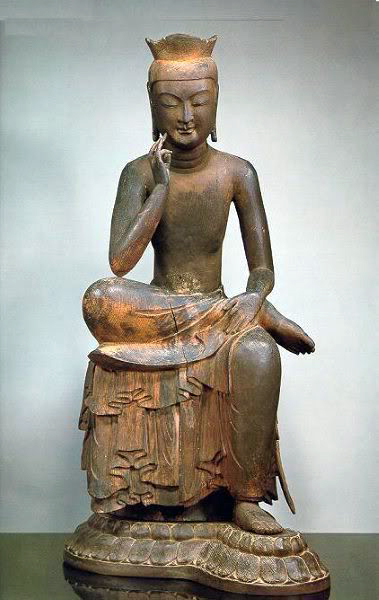
Pensive Bodhisattva, probably Maitreya, 7th century, red pine wood, 163.2 cm high, Koryuji Temple, Kyoto, Japan
In 1965, a large fragment of a granite pensive bodhisattva sculpture was discovered in Bukjiri, which is about 200 km northwest of Gyeongju, the former capital of the Silla Kingdom. Excavations at the site also yielded roof tiles with inscriptions attesting to the presence of a Buddhist temple, as well as a stone platform on which the Pensive Bodhisattva was once presumably placed. Only the lower half of the sculpture remains, but it measures around 170 cm in height. Based on this fragment, the full original sculpture is estimated to have been at least 300 cm tall, making it the largest known pensive bodhisattva image in Asia.
In terms of style, the modeling of the body and the irregularly cascading folds under the right leg are comparable to National Treasure #83. While the provenance of National Treasure #83 has yet to be confirmed, these similarities provide important evidence that it was produced by Silla.
Notably, the same details can also be seen on a Pensive Bodhisattva from Koryuji Temple in Kyoto, Japan, which is often described as the “twin” of National Treasure #83. As compared to the Koryuji sculpture, the Bukjiri sculpture is a bit more striking and elaborate in its details, featuring a slimmer waist and more lavish ornaments on both sides. Thus, it would seem that the Bukjiri sculpture represents the maturation of the influential style of National Treasure #83 and the Koryuji sculpture. With its huge scale and prominent position within the stylistic genealogy, the Bukjiri sculpture demonstrates the increasing significance of religious practices and beliefs related to pensive bodhisattvas.
Additional resources

